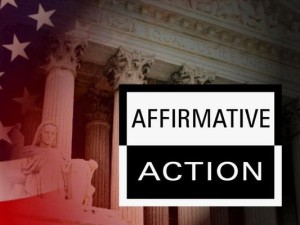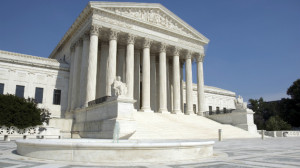U.S. Supreme Court hears case on Michigan Affirmative-action ban
Daily News Article — Posted on October 17, 2013
 (from CBS News) The U.S. Supreme Court heard arguments Tuesday in an affirmative action case. It’s a challenge to a Michigan law that says race cannot be a factor in college admissions.
(from CBS News) The U.S. Supreme Court heard arguments Tuesday in an affirmative action case. It’s a challenge to a Michigan law that says race cannot be a factor in college admissions.
The Court in the past has looked skeptically at using racial preferences in college admissions, but it has stopped short of outlawing it completely. Now the justices are going to have to decide whether bans on affirmative action passed by voters in states across the country violate the Constitution.
After the Supreme Court refused in 2003 to end affirmative action programs at the University of Michigan Law School voters approved Proposal 2, amending the state constitution to prohibit admissions programs that “give preferential treatment to” or “discriminate against” people based on their race.
Michigan Attorney General Bill Schuette said voters wanted to take race out of decision making.
“It’s an expression that in Michigan we think it’s wrong, fundamentally wrong, to treat people differently based on their race or the color of their skin,” said Schuette.
 Michigan is not alone. Five other states, California, Washington, Arizona, Nebraska, Oklahoma, have similar laws outlawing the use of racial preferences.
Michigan is not alone. Five other states, California, Washington, Arizona, Nebraska, Oklahoma, have similar laws outlawing the use of racial preferences.
However, supporters of affirmative action say Proposal 2 amounts to racial discrimination, by rigging the political process against minorities. The federal appeals court agreed and struck down Proposal 2 saying it made it too hard for minorities to change policies that affect them.
“What Prop 2 has done is allow the majority to take away the policy that the university has for hearing everybody’s voice. So essentially the will of the majority has silenced the minority,” said Rosie Ceballo.
Ceballo and her husband Matthew Countryman are professors at the University of Michigan. They said the ban has cut minority enrollment by a third and had a negative effect in the classroom. …
Opponents of affirmative action say the way to increase minority enrollment is to improve opportunities for people before they get to college, at the high school and junior high school levels, but supporters say that doesn’t work.
If the Supreme Court upholds Michigan’s ban many other states across the country may pass similar laws.
Reprinted here for educational purposes only. May not be reproduced on other websites without permission from CBS News. Visit the website at cbsnews.com.
Background
On the Supreme Court from BensGuide.gpo.gov:
- Approximately 7,500 cases are sent to the Supreme Court each year. Out of these, only 80 to 100 are actually heard by the Supreme Court. When a case comes to the Supreme Court, several things happen. First, the Justices get together to decide if a case is worthy of being brought before the Court. In other words, does the case really involve Constitutional or federal law? Secondly, a Supreme Court ruling can affect the outcome of hundreds or even thousands of cases in lower courts around the country. Therefore, the Court tries to use this enormous power only when a case presents a pressing constitutional issue. …
- The Supreme Court convenes, or meets, the first Monday in October. It stays in session usually until late June of the next year. When they are not hearing cases, the Justices do legal research and write opinions. On Fridays, they meet in private (in “conference”) to discuss cases they’ve heard and to vote on them. …
- Most cases do not start in the Supreme Court. Usually cases are first brought in front of lower (state or federal) courts. Each disputing party is made up of a petitioner and a respondent.
- Once the lower court makes a decisions, if the losing party does not think that justice was served, s/he may appeal the case, or bring it to a higher court. In the state court system, these higher courts are called appellate courts. In the federal court system, the lower courts are called United States District Courts and the higher courts are called United States Courts of Appeals.
- If the higher court’s ruling disagrees with the lower court’s ruling, the original decision is overturned. If the higher court’s ruling agrees with the lower court’s decision, then the losing party may ask that the case be taken to the Supreme Court. But … only cases involving federal or Constitutional law are brought to the highest court in the land.
EXPLANATION OF PROCEDURE FOR ORAL ARGUMENTS IN THE SUPREME COURT:
(from supremecourt.gov/visiting/visitorsguidetooralargument.aspx)
- A case selected for argument usually involves interpretations of the U. S. Constitution or federal law. At least four Justices have selected the case as being of such importance that the Supreme Court must resolve the legal issues.
- An attorney for each side of a case will have an opportunity to make a presentation to the Court and answer questions posed by the Justices. Prior to the argument each side has submitted a legal brief – a written legal argument outlining each party’s points of law. The Justices have read these briefs prior to argument and are thoroughly familiar with the case, its facts, and the legal positions that each party is advocating.
- Beginning the first Monday in October, the Court generally hears two one-hour arguments a day, at 10 a.m. and 11 a.m., with occasional afternoon sessions scheduled as necessary. Arguments are held on Mondays, Tuesdays, and Wednesdays in two-week intervals through late April (with longer breaks during December and February). The argument calendars are posted on the Court’s Website under the “Oral Arguments” link. In the recesses between argument sessions, the Justices are busy writing opinions, deciding which cases to hear in the future, and reading the briefs for the next argument session. They grant review in approximately 100 of the more than 10,000 petitions filed with the Court each term. No one knows exactly when a decision will be handed down by the Court in an argued case, nor is there a set time period in which the Justices must reach a decision. However, all cases argued during a term of Court are decided before the summer recess begins, usually by the end of June.
- During an argument week, the Justices meet in a private conference, closed even to staff, to discuss the cases and to take a preliminary vote on each case. If the Chief Justice is in the majority on a case decision, he decides who will write the opinion. He may decide to write it himself or he may assign that duty to any other Justice in the majority. If the Chief Justice is in the minority, the Justice in the majority who has the most seniority assumes the assignment duty.
On the Role of Judges:
Judges are like umpires in baseball or referees in football or basketball. Their role is to see that the rules of court procedures are followed by both sides. Like the ump, they call ‘em as they see ‘em, according to the facts and law-without regard to which side is popular (no home field advantage), without regard to who is “favored,” without regard for what the spectators want, and without regard to whether the judge agrees with the law. (from the American Bar Asociation)
“The role of a judge is to be a neutral interpreter of already established law, not legislator of new law or social policy. A judge can have his or her own opinions, even strong ones, and still read the law neutrally. Fundamentally, judges are expected to not bring their personal politics and philosophies to the bench. Judges are expected to read the law in its clear intent and apply it without regard to result. Changing the law should be left to the people and their legislators.” Sean Rushton, Committee for Justice Executive Director, from the WashingtonPost.com.
“One of the big confusions in the…Senate fight over the confirmation of judicial nominees is that this is an issue about ‘liberal’ judges versus ‘conservative’ judges. The vastly more important issue is whether people who go into court should expect their cases to be decided on the basis of the law or on the basis of the particular judge’s own philosophy…Liberals have rooted for judicial activism because this activism has favored liberal causes and liberal views on such issues as abortion, the death penalty, gay marriage, and racial quotas. But activism can be used by any judge for any purpose.” Thomas Sowell, Hoover Institution
NOTE: ...It is crucial...to have a president who understands the judiciary’s proper role. As Ronald Reagan once noted, “[The Founders] knew that the courts, like the Constitution itself, must not be liberal or conservative.” For Reagan and for the Founders, judges were to be selected based on their ability to put political preferences aside and interpret the Constitution and laws based on their original meaning. Rather than scrutinizing judicial nominees based on their perceived political leanings, [every] president should appoint judges who apply the law regardless of their own policy preferences. (from “Misunderstanding the Role of Judges” by Deborah O’Malley)
